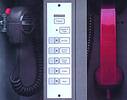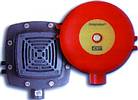

One of the most overlooked items in a fire alarm system is the correct design use and installation of fire warning devices. This is quite clearly explained in the South African Standard SABS 0139, paragraph 9.
The basic requirement is that there should be a minimum sound level of 65 dB(A) or 5 dB above ambient noise levels in all accessible parts of the buildings. Sounder circuits are considered primary circuits and should be cabled with fire retardant cables as specified in SABS0139.
One of the most frightening experiences that one could ever face is to be lost and disoriented. Under such circumstances, the ability to process and store environmental information deserts one and, because most of us are dependent upon others knowing their way, or 'information' such as signs pointing the way, our very survival may be threatened. Smoke-filled environments lead to disorientation and panic and any means of assisting people to find the exit routes is important.
The emergency situation
Behavioural studies have repeatedly shown that one of the most natural instincts in the event of a fire is to evacuate a building by the route by which it was entered. More often than not, this is rarely the quickest or most appropriate way. Many people fail to spot nearby exits, and in some cases walk straight past visible fire exits.
The repercussions of such actions have, in many cases, been severe. Certain circulation routes (generally those used for normal, everyday movement) encounter a higher population flow than they were designed for, leading to overcrowding and a slowing down of the evacuation process. As a result, some building occupants are exposed to deadly smoke, fumes and flames.
System designers often neglect to give sufficient consideration to the method used to signal a fire alarm for an emergency situation. Little or no attention is paid to the environment in which the fire alarm system is to be installed.

Audible alarms
The four main categories of audible alarms are bells, sounder/strobes, sounders with prerecorded voice signals, and voice evacuation systems. Each of these types of fire alarm signalling has a place and application.
Bells
A traditional method of signalling a fire alarm, bells are still common throughout industry and commerce. The main advantage of the bell is that it is available at low cost, the signal is well recognised and the sound output in terms of dB level is adequate for most internal building uses. However, the main disadvantages are high current consumption compared with other methods of signalling. Furthermore, bells for outdoor use generally require some form of weather protection that tends to not only reduce the dB sound output level but also adds to the initial expense.
Sounders/strobes
Sounders have become the bedrock of fire alarm signalling. The advantages of this type of signalling include:
* Cost-effective.
* Sound output ranging from around 70 dB to over 125 dB.
* Indoor and outdoor models.
* Flameproof and intrinsically safe versions readily available.
* Low current consumption.
* Can be line-powered for addressable systems.
* Can easily be combined with strobes.
* Strobe sounder units can be used to signal fire alerts to the hard of hearing.
Sounders with prerecorded voice alarm
In recent years a number of sounders have emerged overseas that have some voice capability. Such sounders normally operate by signalling an alert, as an electronic sounder, and interspersing these alert signals with a pre-recorded voice message, ie 'Please evacuate the building.' However, this technology has been slow to gain acceptance for various reasons.
Messages have to be restricted to very simple instructions that cannot be misinterpreted by the building occupants. For instance if the building in question was a multi-storey office block of say 20 floors, then should it be required to evacuate or warn each floor independently then obviously 20 different voice recorded signals would be required. In practical terms this simply is not feasible. In brief it will be necessary to predict each and every event in order to prerecord the necessary specific voice instruction. Hence instructions on these types of sounder voice alarms are generally restricted to broad-based messages. Other disadvantages with the sounder voice alarm products are their inherent high current consumption and associated high cost.
For these types of products it is also necessary to provide multilingual facilities hence requiring even more pre-recorded memory space. However, these sounders have proved popular in concept in the security markets where specific authorisation messages can be issued that generally do not involve the life safety aspects normally associated with fire. It is most likely that this is the market niche for this product.
Voice evacuation systems
These systems have been prevalent within South Africa for many years and provide a comprehensive method of broadcasting specific signals and instructions associated with a real fire situation. The fireman's microphone is a common product to be found in most commercial buildings. However, it should be noted that the voice evacuation system is utilised as a backup to the normal sounder/strobe fire warning system. A study of the location acoustics may be necessary if the broadcast speech is to be clear and understandable.
These systems, if utilised in buildings with unusual architecture (railway stations, museums, etc) will require engineering in order to operate effectively with the inherent acoustics characteristics of such buildings. This in turn adds to the cost, thereby making this an expensive form of fire alarm signalling.
Conclusion
Price is always an important factor when choosing the correct warning method, however, what price can be attached to lives? The choice of warning and evacuation system varies in relation to the environment they are to be used.
Bells may be suitable for an office environment but could not be considered for a noisy factory. Engineering has to be conducted for satisfactory operation of a public address system but, whatever the preference, careful consideration must be given to this area and must comply to the South African Standard SABS 0139 and British Standard BS5588.
For further details contact the FDIA on tel: (011) 397 1618.

© Technews Publishing (Pty) Ltd. | All Rights Reserved.